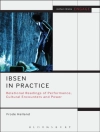What is folk horror and how culturally significant is it? This collection is the first study to address these questions while considering the special importance of British cinema to the genre’s development.
The book presents political and aesthetic analyses of folk horror’s uncanny landscapes and frightful folk. It places canonical films like Witchfinder General (1968), The Blood on Satan’s Claw (1971) and The Wicker Man (1973) in a new light and expands the canon to include films like the sci-fi horror Doomwatch (1970–72) and the horror documentary Requiem for a Village (1975) alongside filmmakers Ken Russell and Ben Wheatley.
A series of engrossing chapters by established scholars and new writers argue for the uniqueness of folk horror from perspectives that include the fragmented national history of pagan heresies and Celtic cultures, of peasant lifestyles, folkloric rediscoveries and postcolonial decline.
Tabla de materias
Foreword by John Das
Introduction: what makes the folk horrific? – Louis Bayman and K.J. Donnelly
Part I: Debating The Wicker Man (1973)
1 The context of The Wicker Man – Ronald Hutton
2 A deeply religious people: The Wicker Man, contemporary paganism, and Dracula reversed– Laurel Zwissler
3 Folk horror: a discursive approach, with application to Robin Hardy’s The Wicker Man (1973) and Neil Jordan’s The Company of Wolves (1984) – Mikel J. Koven
Part II: Return of the British repressed
4 The folk of folk horror – Derek Johnston
5 Doomwatch: sacrifice zones and folk horror – Dawn Keetley
6 My ancestors died here: Requiem for a Village and the rural English horror of modernity and socio-cultural change – Paul Newland
7 Outsider history, or outside of history – K. J. Donnelly
8 Anglo creep and Celtic resistance in Apostle – Beth Carroll
9 Women’s folk horror in Britain: history, industry, style – Amy Harris
Part III: Folk horror’s cultural landscapes
10 Ritualistic rhythms: exploring the sensory effect of drums in British folk horror cinema – Lyndsay Townsend
11 ‘Nature came before man’: human as subject and object within the folk horror anti-landscape – David Evans-Powell
12 Hieroglyphics: Arthur Machen on screen – Mark Goodall
13 Albion unearthed: social, political and cultural influences on British folk horror, urban wyrd and backwoods cinema – Andy Paciorek
14 ‘Isn’t folk horror all horror?’: a wyrd genre – Diane A. Rodgers
Index
Sobre el autor
Louis Bayman is Associate Professor of Film Studies at the University of Southampton K. J. Donnelly is Professor of Film and Film Music at the University of Southampton












